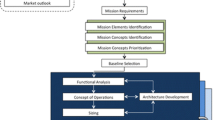Abstract
The early stages of a space mission design are crucial for the development of the whole project because they strongly influence the ensuing design phases. Moreover, feasibility assessment at early stages brings to time and cost reductions and strongly determines the overall performances of proposed solutions. Concurrent Engineering (CE) is a systemic and systematic design strategy that employs real-time interdisciplinary activities for products development. The advantage of the CE approach is particularly noticeable in the study of systems of high complexity, as space exploration systems do. The aim of this work is to show how a Concurrent Design approach can be very profitable in the development of a pre-phase A study of an interplanetary space mission, by means of a greater and effective exchange of information, enlarging the solutions tradespace, highlighting system criticalities and solving inter-subsystems conflicts. The case study, TRIton Tomography Orbiter (TRITO), is conceived as a mission to investigate the Neptune planetary system and its main moon Triton, which is of scientific interest due to its geological activity and the possible presence of subsurface oceans. The possibility of a pre-science phase in orbit around Neptune has been considered, giving the opportunity of precise measurements of its gravitational and magnetic field, together with its upper atmosphere composition. Therefore, a complex suite of instruments composed of magnetometers, laser altimeters, cameras and spectrometers, constitutes the payload, supported by a spacecraft able to face challenging environmental conditions during its whole spaceflight, ending with an aerocapture manoeuvre within the Neptune atmosphere. The collaborative approach, through the use of a modern CE design tool, is demonstrated to be very helpful not only in finding solutions meeting the strict constraints imposed by the harsh environmental conditions, but also for the individuation of optimum solutions related to mission analysis and mass budget aspects according to the system criticalities. The CE approach has been demonstrated to be an unavoidable design methodology for the development of systems showing a high level of subsystems interconnections and simultaneous interactions of different engineering domains, permitting to manage the growing design complexity.






Similar content being viewed by others
Abbreviations
- TRITO:
-
Triton tomography orbiter
- CE:
-
Concurrent engineering
- IDM:
-
Integrated design model
- CNES:
-
Centre National d’Etudes Spatiales
- CIC:
-
Centre d’Ingénierie Concourante
- SC:
-
Spacecraft
- HGA:
-
High gain antenna
- LGA:
-
Low gain antenna
- RTG:
-
Radioisotope thermoelectric generator
- ADCS:
-
Attitude determination and control
- AC:
-
Aerocapture manoeuvre
- WAC:
-
Wide angle camera
- NAC:
-
Narrow angle camera
References
Gaeman J, Hier-Majumder S, Roberts JH (2012) Sustainability of a subsurface ocean within Triton interior. Icarus 220:339–347
Bandecchi M, Melton B, Gardini B (2000) The ESA/ESTEC concurrent design facility. In: Proceedings of the EuSEC 2000, pp 329–336
Gaudenzi P, Di Domizio D (2008) A model for preliminary design procedures of satellite systems. Concurr Eng 16(2):149–159
IDM-CIC and IDM View (2014) An editor and a viewer of engineering models—SECESA 2014. University of Stuttgart, Stuttgart (8 October 2014)
Simonini L, Garcia G, Le Gal JL (2014) Compatibility analysis between CNES IDM CIC v3 data model and ECSS ECSS-E-TM-10-25—SECESA 2014. University of Stuttgart, Stuttgart (8 October 2014)
Hughes KM, Moore JW, Longuski JM (2014) Preliminary analysis of ballistic trajectories to Neptune via gravity assist from Venus, Earth, Mars, Jupiter, Saturn and Uranus. Adv Astronautic Sci 150:1535–1554
Lockwood MK (2004) Neptune aerocapture systems analysis. AIAA Paper No. 2004-4951
Author information
Authors and Affiliations
Corresponding author
Rights and permissions
About this article
Cite this article
Pollice, L., Cascioli, G., Federici, L. et al. A Preliminary Design of a Mission to Triton: A Concurrent Engineering Approach. Adv. Astronaut. Sci. Technol. 1, 103–110 (2018). https://doi.org/10.1007/s42423-018-0001-9
Received:
Revised:
Accepted:
Published:
Issue Date:
DOI: https://doi.org/10.1007/s42423-018-0001-9




